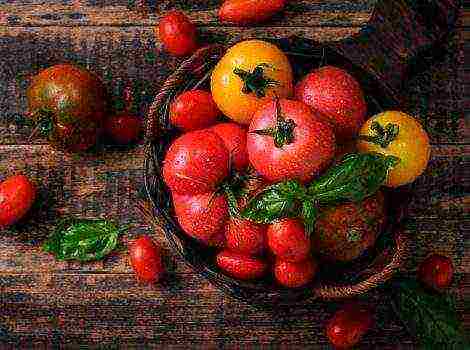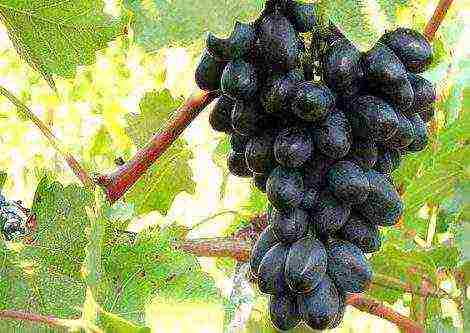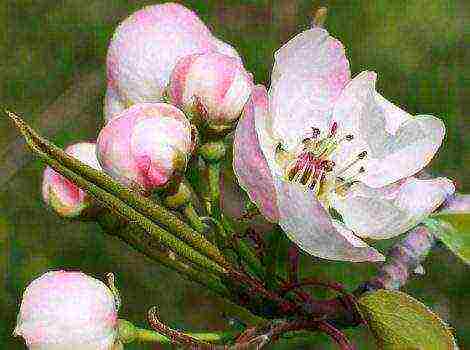Content
- 1 Material content:
- 2 Characteristics of potato varieties
- 3 Seed potato varieties - choosing the right one
- 4 The best potato varieties for the Moscow region
- 5 Popular potato varieties for the middle lane
- 6 Optimal potato varieties for Siberia
- 7 Early potato varieties: photo and description
- 8 Medium early potato varieties: the best varieties
- 9 Mid-season potato varieties with a detailed description
- 10 Mid-late potatoes: the best of the best
- 11 Late potato varieties: features with illustrations
- 12 Classification of potato varieties
- 13 Overview of potato varieties
- 14 Potato varieties for different regions of the country
- 15 Potato varieties by purpose
- 16 Reviews of potato varieties
- 17 Early potato varieties
- 18 Medium early potato varieties
- 19 Mid-season potato varieties
- 20 Late varieties of potatoes
- 21 Interesting varieties not included in the state register
Potatoes have long established themselves as one of the most popular and beloved vegetables. It is highly valued not only for its taste, but also for its easy and quick preparation. Boiled potatoes whole, without skin, fried and create on its basis various dishes, ranging from side dishes to soups.
Unfortunately, potatoes are among those types of vegetables that are extremely dependent on care from the summer resident and favorable climatic conditions. Otherwise, the yield will be so weak that you will have to abandon the idea of growing potatoes in your summer cottage in the future.
Which varieties can easily adapt to harsh climates and how difficult will it be to care for them? Answers to these and many other questions are waiting for you in this article.
Material content:
- Characteristics of potato varieties
- Seed potato varieties - choosing the right one
- The best potato varieties for the Moscow region
- Popular potato varieties for the middle lane
- Optimal potato varieties for Siberia
- Early potato varieties: photo and description
- Medium early potato varieties: the best varieties
- Mid-season potato varieties with a detailed description
- Mid-late potatoes: the best of the best
- Late potato varieties: features with illustrations
Characteristics of potato varieties
Faced for the first time with a huge variety of potato varieties, it is very difficult to understand which of them are intended for human consumption and which ones are optimal as food for farm animals. To make it easier for you, we provide a simplified diagram of the characteristics of varieties.
Common varieties of cultivars
- Canteens... The most common varieties that have the best taste. Because of this feature, they are commonly used for cooking.
- Technical... These varieties contain an underestimated amount of protein, so they are intended for the manufacture of alcohol and starch.
- Fodder... By virtue of their name, these varieties are used to feed livestock. They are distinguished by the fact that the level of protein and starch is much higher than normal.
- Universal... These varieties have everything you need to target any of the above tasks.
In addition, potato varieties can vary according to the following criteria: early maturity. Unlike other vegetables, there will be more criteria that cover the duration of fruit ripening.
Varieties of varieties by ripening period
- Early. Fruits appear after 50-65 days.
- Medium early. Fruits appear after 65-85 days.
- Mid-season. Fruits appear after 85-95 days.
- Medium late. Fruits appear after 95-110 days.
- Late. Fruits appear after 95 days or more.
Seed potato varieties - choosing the right one
It is worth saying that potatoes have weaker protection against all kinds of pests and infections than other vegetables. If this is not taken into account, the tubers will work solely to survive, and not focus on a good harvest.
The only exceptions can be those varieties that successfully resist many of their varieties. But not all resistant varieties are distinguished by the best taste and large-fruited. That is why the choice of varieties must be taken with full responsibility.
It should also be borne in mind that after 3-4 years the variety will degenerate, which means that it is necessary to find an appropriate replacement for it. Elite planting material can be an ideal option. It will be extremely difficult to grow it on your own, because this is a very long and capacious process that requires specific conditions.
When buying it, it will not be superfluous to ask the seller about the quality certificate. This is important due to the fact that very often sellers can offer ordinary potatoes instead of the desired elite planting material.
If you do not want the acquired planting material to become unusable too quickly, then it should be dug out before the lion's share of the crop begins to appear.
As for the characteristics of the varieties, here it is also worth being vigilant not only about traditional factors (taste, yield and large-fruited), but also several others (early maturity and the place where it comes from). Compliance with the latter factor will help determine the compatibility of the climatic zone, which is extremely important when growing potatoes.
The best potato varieties for the Moscow region
Many summer residents who grow potatoes in the Moscow region managed to note that this activity is extremely risky. Due to non-standard climatic conditions and many other factors, when choosing varieties for planting, several important features should be noted for yourself.
First, the varieties must have good protection against pests and diseases. Secondly, you should choose only early, mid-early and mid-season varieties. If you go into experiments and take later varieties for planting, then they simply will not have time to ripen.
Additionally, you need to pay attention to whether they are intended for landing in the Moscow region. If the selected variety does not have this indicator, but it easily enough adapts to existing conditions, then this item can be skipped.
List of potato varieties
Nevsky
The variety is considered medium early because the ripening period for the fruit is 75 to 85 days. The bush can produce up to 15 tubers, each of which will weigh an average of 90-140 grams. Average yields per hectare are up to 360 centners.
The variety can be used for various purposes because it is versatile. The fruits are characterized by excellent taste and the ability to maintain their appearance for a long time.
Common viral diseases and late blight will not interfere with this variety. However, he will need protection from the potato nematode.
Sorcerer
This variety is characterized by several features at once: early maturity, resistance to drought and late blight, as well as extraordinary productivity. The fruits can be stored for a long time. Each bush is capable of producing up to 15 tubers.The weight of one tuber can reach 200 grams.
Separately, it is worth noting its protection against potato nematodes and scab. Due to its distinctive taste characteristics, the Sorcerer is considered one of the most delicious among domestic and foreign varieties.
Lorch
The presented variety is considered late and extremely popular among summer residents. It is considered universal, therefore it can be used for absolutely any purpose. The taste characteristics, as well as the ability to be stored for a long time without changes, are at a high level. One tuber can weigh 140 grams.
Usually, the shape of the tubers is round-oval, but if there is not enough phosphorus and potassium in the ground, it will become oblong.
Luck
This variety forms tubers early enough, and their number will overshadow any ideas about high yields (up to 120 kilograms per bush). The average weight of one tuber is 130 grams. Taste characteristics are above normal. Long-term storage will not affect the appearance.
Dry periods are not terrible for this variety, however, all kinds of pests can significantly weaken it. Among them are late blight, scab and viral infections. When planting, you can pay attention to the quality of the soil, because the variety perfectly adapts to existing conditions.
Sineglazka
This variety is considered medium early, which is able to surprise with a rich harvest and excellent taste. Long-term storage in small volumes will take place for fruits without any problems. If this fact is not taken into account, then the external characteristics will be significantly underestimated.
Separately, it should be said about the resistance to common infections and diseases. Due to its table type, the main purpose is cooking.
Popular potato varieties for the middle lane
The climate in central Russia is temperate, therefore, for the successful cultivation of potatoes, it is necessary to select varieties that can be successfully grown under existing conditions. The main criterion is early maturity. Otherwise, the potatoes may not have time to produce a decent level of yield.
List of potato varieties
Rocco
One of the most productive varieties, which also successfully resists late blight and Y and Yn viruses. Moreover, a sudden drought and the machinations of potato crayfish are not afraid of him. The tubers are large enough and capable of both long-term transportation and long-term storage.
On average, one tuber weighs up to 120 grams. The number of tubers from one bush exceeds 12 pieces. Due to their delicious taste, the tubers can be used for a variety of purposes, including cooking and feeding livestock.
Slav
A mid-season variety that has a fairly high taste and is ready to please the summer resident with incredible yield indicators (more than 500 centners per hectare). The fruits are extremely large and oblong-oval in shape.
Excellent protection against such phenomena as hookworm, cancer and viral infection. In addition, the variety copes well with late blight. Despite the fact that it does not require high quality soil, the amount of fertilizer required should be increased, taking into account its intensity.
During long and not careful transportation, potatoes can be damaged, but at rest they will remain unchanged.
Kiwi
A mid-season variety with a decent yield level. Has reliable protection against the Colorado potato beetle, wireworm, as well as many infections and diseases. A separate plus can be considered the ability of the variety to quickly adapt to existing conditions, so caring for the bush will be greatly simplified.
Adretta
Here is a foreign mid-season variety that boasts several advantages at once.Excellent taste characteristics, good protection against many infections and diseases, and excellent yield. One bush forms an average of 10 tubers.
In the event of a change in climatic conditions, the variety will show itself perfectly without sacrificing a high degree of yield. Tubers can be stored for a long time, including in the winter season.
Rosara
This foreign variety is considered one of the earliest, the tubers of which ripen after 65-70 days. It is especially popular with farmers who grow potatoes for sale. The yield reaches 300 centners per hectare.
The variety is characterized by optimal conditions for long-term storage and transportation. Excellent protection against potato nematodes, potato crayfish, late blight and scab. It is relatively resistant to the Y virus, but has a better chance of coping with the Yn virus.
Optimal potato varieties for Siberia
The climate of Siberia can be a real challenge for many varieties of potatoes. Not everyone can withstand the effects of late spring and early autumn cooling, abnormal heat in July and prolonged rains in August. To solve these problems, special varieties were bred for Siberia, which can give a good harvest in a short summer.
In addition, there are several domestic and foreign varieties that, due to their characteristics, can be successfully grown in the harsh climate of Siberia.
List of potato varieties
Red Scarlett
Here is a representative of one of the most popular red-skinned varieties, which is mainly used in the central and southern regions of the country. The yield reaches 660 centners per hectare. The tubers are not only large, but also beautiful.
Upon receiving physical damage and cooking, the fruits do not change their color. In addition to good resistance to many infections and diseases, including late blight and potato nematode, the variety can successfully withstand the effects of prolonged drought.
Timo
This is one of the earliest ripening varieties that can be successfully grown not only in Siberia, but also in other regions of Russia. The maximum yield is over 610 centners per hectare. Summer residents do not cease to argue that the tubers are incredibly tasty and can be stored for a long period. Excellent protection against potato cancer.
Gloria
A mid-early potato variety that will delight you with the excellent taste of tubers. In addition, they can lie for a long time without any changes. The yield per hectare noticeably exceeds 370 centners.
The variety shows increased resistance to such phenomena as scab, potato nematode, potato cancer and a number of viral diseases. Tops do not cope with late blight as well as with the above infections.
Ermak
Here is the modernized Early Rose variety. Excellent taste characteristics, high yield (45 kilograms per 10 square meters), as well as good resistance to common diseases and infections. Separately, it is worth noting the rapid adaptation to low temperatures. The mass of one tuber is up to 115 grams.
Redstar
This is a mid-early variety, which differs in varying degrees of resistance to a huge number of pests and diseases. Basically, he does a good job of dealing with the problems that have arisen. Tubers include unique flavoring properties that allow them to be used for preparing a wide variety of dishes.
With moderate physical damage, the potatoes will not be damaged. During long-term storage, the external features of the tubers will remain unchanged.
Early potato varieties: photo and description
Impala
This variety is a table variety, so it can only be used for cooking. Excellent taste also contributes to this.With proper care, the variety can consistently please with a large harvest, reaching up to 620 centners per hectare.
Tubers can weigh up to 150 grams. Perfectly stored and transported. Well protected against potato nematodes and potato crayfish.
Arrow
A table variety whose tubers are intended for cooking. They are large enough, do not darken during cooking, and also have an excellent presentation. With all this, the variety is high-yielding.
Strawberries can successfully resist scab, late blight and potato nematode. However, the tops are vulnerable to late blight and Y.
Sturdy
The variety is more popular in the central regions of the country. The yield is moderate - up to 276 centners per hectare. The tubers are delicious and can be stored for a long period.
Antonina
The variety is primarily targeted at the West Siberian region. Under appropriate conditions, storage can last for a long time and this will not affect the quality of the tubers. The yield reaches 300 centners per hectare.
Kholmogorsky
A high-yielding variety (almost 400 centners per hectare), which is popular in the northern region. The tubers are tasty, do not boil over and can be stored for a long time.
Medium early potato varieties: the best varieties
Romano
The variety was developed in the Netherlands. Its value lies in its high yield, large tubers (up to 182 grams), as well as their taste characteristics. Late blight is its main problem. He can easily cope with other diseases.
Russian souvenir
This variety is more popular in the North Caucasus region. Tubers of this variety are oval and tasty. They can be stored for a very long time. The yield per hectare ranges from 165 to 365 centners.
Odysseus
The variety was developed in the Central Black Earth Region. Tubers are well stored and transported without loss of quality. Excellent taste characteristics. The yield of the variety reaches 300 centners per hectare.
Visa
Here is a very productive variety, which, under favorable conditions, will delight more than 460 quintals of delicious potatoes per hectare. The resulting crop can be stored for a long period.
Santa
Champion among fruitful varieties! The maximum yield reaches 570 c / ha. Purpose - cooking and potato chips. It has tremendous protection against late blight, as well as a number of other diseases.
The tubers are very tasty and able to lie and be transported for a long time without losing their presentation.
Mid-season potato varieties with a detailed description
Scarb
A very productive variety that will yield up to 650 centners per hectare. The tubers are not only large, but also extremely tasty. The main diseases are not terrible for him, but such a variety as late blight will cause a lot of problems for the tops and tubers.
Dubrava
A table variety, which is also facilitated by the excellent taste and optimal properties of the tubers. Can be grown on almost any type of soil. The yield is high - up to 540 centners per hectare. It copes well with all kinds of diseases and infections. Long-term transportation and storage will not spoil the taste and external qualities of the tubers.
Sap
The variety is interesting in that it can withstand drought, but does not tolerate excessive watering. Otherwise, the tubers will begin to crack. The storage of tubers can take place over an extended period.
This variety can successfully fight back the main types of infections and diseases. It is considered high-yielding with indicators of up to 550 centners per hectare.
Krinitsa
The variety germinates well when the soil is one-dimensional. Able to surprise with a high yield, reaching 500 centners per hectare. The tubers are distinguished by excellent taste and the ability to be stored for a long time without changes. Most viruses and infections are not scary to the strain.
Yanka
The variety is characterized by tremendous yield indicators, which can reach almost 630 centners from one hectare! Tubers are able to surprise, both with taste and long-term storage. Potato nematode and various viruses are not terrible for this variety, however, wet rot and late blight can cause a lot of complications in it.
Mid-late potatoes: the best of the best
Blakit
The variety is distinguished by excellent and stable yield, tasty and large tubers, as well as reliable protection against many infections and diseases, including scab, potato nematode and late blight. The cultivation process can be followed on almost any type of soil.
Aurora
A high-yielding and disease-resistant variety that is considered a table variety. Up to 14 tubers can be harvested from one bush. They will pleasantly surprise you not only with their taste, but also with their size. They can be stored for a long period without external changes.
Ragneda
Tubers of this variety are primarily intended for subsequent sale. They are distinguished by their excellent presentation, which will not change after moderate mechanical damage, as well as excellent taste. The variety is quite resistant to potato nematodes and cancer, and also has almost immunity from many viruses and ditylenchiasis. Up to 14 tubers can be obtained from one bush.
Picasso
The variety was developed in Holland. Differs in good protection from both known and rare diseases and viruses. One bush can produce up to 19 large tubers with good taste. Long-term storage will not affect the external characteristics.
Lasunok
The main features of this variety are its excellent taste characteristics. At the same time, tubers are not afraid of long-term storage and transportation. The variety has good protection against all diseases, except late blight.
Late potato varieties: features with illustrations
Vesnyanka
The phenomenal yield (up to 660 centners per hectare) makes this variety extremely attractive for summer residents. Taste characteristics are moderate, as well as protection from many diseases. Growing can take place on almost any type of soil, and the tubers will last for a very long time.
Atlant
Another record holder in terms of yield among late varieties. Under favorable conditions, you can get up to 660 centners per hectare. Shrubs should not be over-watered, especially during the second growing season. The palatability significantly exceeds the norm. The variety is well protected from late blight and viral diseases, but it copes satisfactorily with potato nematode and scab.
Pace
The unique feature of this variety is its easy and quick adaptation to any type of soil and potash fertilizers. It successfully resists the influence of late blight and scab, but it is necessary to protect the variety from viral diseases. The tubers have excellent taste and can be processed.
Climber
The variety can grow on any soil, including peat-bog soil. Excellent resistance to late blight, wet rot and potato nematode. The tubers are very tasty. The yield reaches 500 centners per hectare.
Zarnitsa
To grow this variety, you need to take into account the characteristics of the soil, but you can ignore the prolonged drought. Application of mineral fertilizers is possible. One bush can produce up to 16 tubers. Potatoes taste great and can be stored for a very long time. Disease and virus resistance is above average.
In this video, you can learn a lot of interesting things about the potato varieties mentioned above.
Breeders have bred more than 280 varieties of potatoes, which are recommended to be grown in personal plots. The best varieties of potatoes are characterized by good yield, excellent taste and presentation, immunity to bacteria and viruses.
Classification of potato varieties
Ripening classification:
- ultra early - up to 1.5 months;
- early - up to 2 months;
- medium - up to 3 months;
- late - from 3 months to 140 days.
Potato varieties are bred for different purposes:
- fodder - used as fodder for livestock; potatoes are large, contain a lot of protein and starch;
- universal - allowed for use in cooking and for feeding livestock; with a starch value of 16-18%;
- technical - dry matter more than 16%, are used as raw materials for the production of starch and alcohol;
- canteens are of the greatest interest for gardeners, as they are used in cooking.
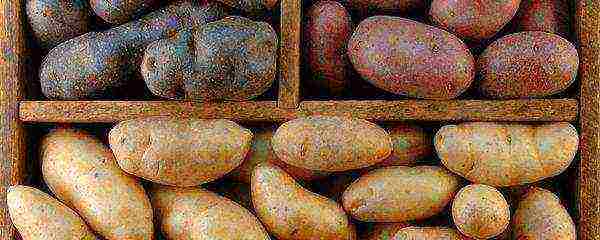
Table varieties contain a different percentage of dry matter - starch and are divided into types:
- Type A - low dry matter value up to 14%; the tubers are dense, do not boil over, they are used for side dishes and salads.
- Type B - 14-17% starch; this type includes varieties that are used for frying and making chips.
- Type C - from 17 to 20% dry matter; average cookability.
- Type D - starch value up to 25%. This type includes varieties of fully boiled potatoes, which are used to obtain dry mashed potatoes.
Characteristics of the color of the peel:
- red peel - shelf-stable potatoes, contains a lot of antioxidants;
- white and yellow potatoes — taste good and have more starch than red tubers.
Overview of potato varieties
Below we take a look at the most popular potato varieties for various characteristics.
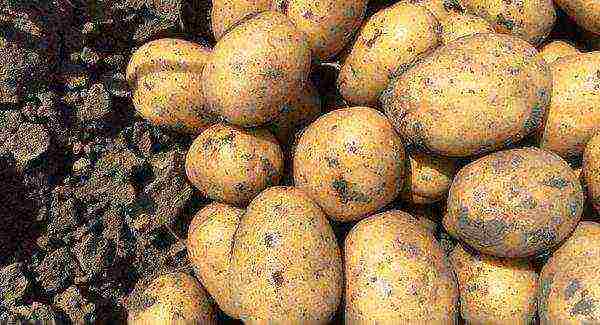
Super early varieties
The growth period is 45-60 days. Their advantages are minimal watering 2-3 times, resistance to late blight and the ability to harvest twice a season.
The main disadvantage of early potato varieties is that the tubers are not suitable for storage, as their skin is very thin. The harvest quickly becomes sluggish and loses its flavor.
- Impala is a Dutch selection. Resistant to damage during harvesting. Tubers are slightly oval, ripen in 50 days. The surface is yellow, has no roughness, the average starch is up to 15%, the weight of the potato is 160 g.
- Bellarosa - bred in Germany. The shape of the potato is spherical, weight - 200 g, the flesh on the cut is beige, the skin is rough, pinkish. Immune to bacteria.
- Alyona. A variety of oblong potatoes. The tuber weighs 130 g, the peel is pinkish. The pulp is light beige, does not darken during cooking; dry matter content 15%.
- Riviera. Dutch variety. Potato - rounded, weight - 140 g. Peel - yellowish, flesh - beige, starch up to 16%.
- Timo. Finnish potatoes. The growth period is 45 days. Potatoes weighing up to 120 g, round. Smooth surface of the tuber, brown-yellow color; starch - up to 14%, the pulp is pale, almost white.
Medium varieties
With a ripening period of up to 100 days. They are grown for storage for the winter, as the tubers are mature and do not germinate until spring.
- Gala. A spherical vegetable with light flesh and brownish peel. Tuber weight - 120 g. It has average starch values.
- Red Scarlett. Dutch selection. The tubers are oblong with a flat surface. The skin is reddish, the flesh is almost white. Weight - up to 120 g.
- Rosara. A variety of German selection. Tubers grow up to 70 days. The shape of the potato is oblong, weighing 150 g, with beige pulp and pinkish skin.
- Karatop. The tubers mature for 70 days. Little eyes. The potatoes are elongated, the peel is brownish, the flesh is pale yellow.
- Sante is a Dutch selection. Vegetable weighing 80 g, with a golden skin, cream tuber on the cut.
Late varieties
The growth period is from 90-140 days. They contain the maximum amount of carbohydrates and nutrients. They are stored for a long time until the next harvest without germination. Tubers are less likely to suffer from diseases.
- Picasso is a Dutch breeding potato. There is little starch in the composition, it does not boil over. A vegetable weighing 120 g, creamy on the cut, the skin is yellow with burgundy specks.
- Pace.Potatoes weighing 150 g, contains 22% starch; on the cut - beige.
- Nevsky. The tuber is round, 120–130 g, pale cream on the cut. The surface is without roughness, pale yellow, the eyes are pinkish, shallow.
- Nikulinsky. The vegetable weighs 90 g, elongated, the skin is light beige with pinkish spots, on the cut of the potato it is snow-white.
- Zhuravinka is a Belarusian selection. Oval tubers of a pinkish hue, up to 160 g. Does not suffer from drought.
The most productive varieties
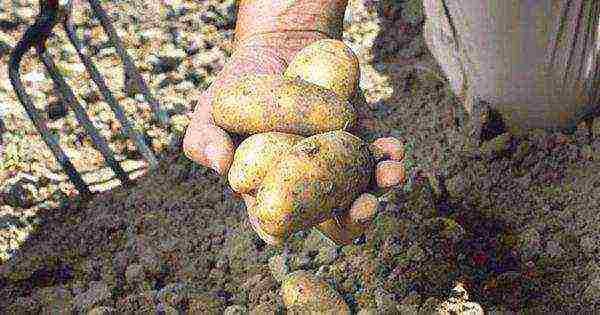
They give over 350 centners per hectare, and with the addition of additional fertilizing and proper watering - up to 800 centners per hectare.
- Temp - tubers are large, with a yield of 550 c / ha.
- Good luck - with an average starch index, it is capable of producing a yield of 960 c / ha.
- Zhukovsky. Vegetable weighing 165 g, with a yield of up to 500 c / ha. The skin of the tuber is pink, the flesh is pale yellow.
- Bellarosa. A very early variety, which, with proper care, gives a yield of young potatoes of 400 c / ha.
- Idaho. Early potatoes with starch up to 17%. The tuber rind is smooth. Productivity - up to 600 kg / ha.
The most delicious varieties
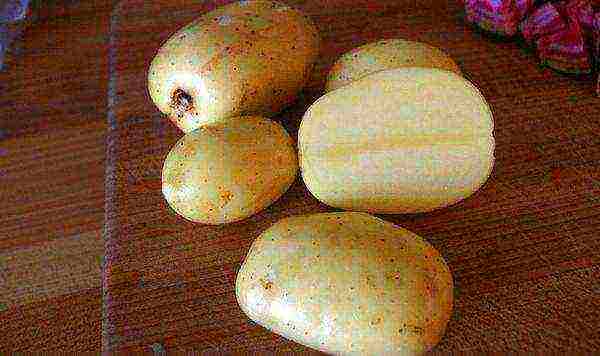 Mona lisa
Mona lisa
They contain a lot of amino acids, starch, bioflavonoids and fiber.
- Mona Lisa is a mid-early variety. Potato weight - 80 g; the skin is hard.
- Bentier is a medium early potato. The skin is brown, the cut is a beige pulp, weight is 120 g, there are few eyes.
- Symphony is a medium-ripening variety. The color of the potato is red, the flesh is yellowish, weight 120 g.
- Adretta. Spherical potatoes. The rind and flesh are beige; the surface of the tuber is rough.
- Simpley Ed. Reddish tuber, flesh - beige, contains many antioxidants.
For clay and sandy soils
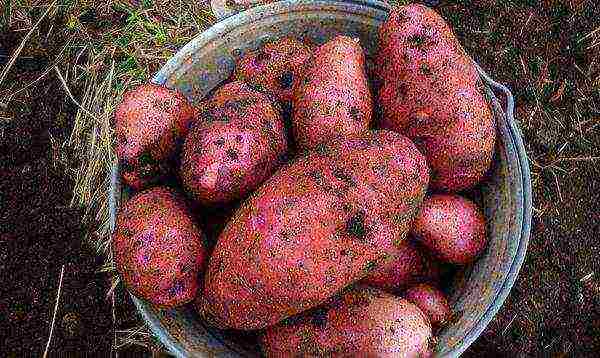 Rodrigo
Rodrigo
Potato varieties are selected that are capable of bearing fruit on heavy, dense soils. In clay areas, water stagnates after heavy rains, and a crust forms when it dries.
Sandy soils have low porosity, quickly pass air and water, and are not able to retain moisture. For such plots of land, you need to choose drought-resistant varieties.
- Gatchinsky. Potato shape - spherical, weight - up to 140 g; the pulp is creamy. Productivity - up to 450 kg / ha.
- The glow is a mid-late potato. The skin is pinkish, the tuber on the cut is white, the dry matter content is 22%. Productivity - up to 400c / ha. It has wide leaves that do not allow moisture under the bush to evaporate quickly.
- Bellarosa - on heavy soils forms up to 10 tubers weighing 150-200 g on a bush. The root system penetrates deep into the ground, where it extracts water and nutrients.
- Cleopatra is a Dutch variety. The skin is red, the flesh is pale yellow, starch is 13%; tubers are large.
- Rodrigo is a German-bred potato. Large tubers up to 200 g, the skin is reddish, the flesh is beige.
Universal varieties capable of bearing fruit on different soils - "Zhukovsky", "Nevsky".
Potato varieties for different regions of the country
The climate of different regions of the country is different. Therefore, for each zone, potatoes are selected that can bear fruit well in certain weather conditions.
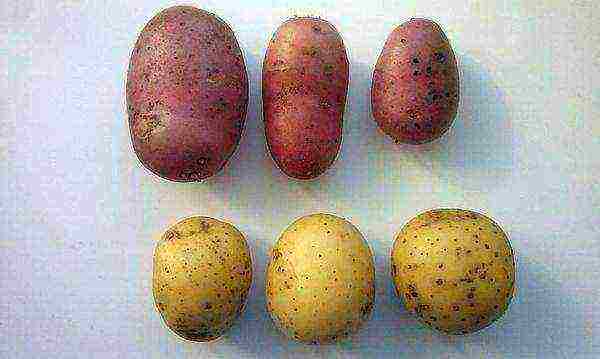 Rodrigo and Gala
Rodrigo and Gala
For Moscow region
The climate is moderately continental with relatively mild winters and rainy summers. The first frosts are possible from mid-September.
It is recommended to plant the best early varieties: Impala, Nevsky, Zhukovsky, Vesna, Luck, Bellarosa, Sineglazka, Bryansky Early.
For Siberia
An area with a sharply continental climate, with late spring frosts, short summers and heavy rains at the end of the summer.
Under such conditions, early and middle varieties are grown: "Tuleevsky", "Nevsky", "Adretta", "Impala", "Luck", "Lyubava".
For the Urals
A short warm period is characteristic, especially in the north and in the central part of the region. Choose early and medium varieties for cultivation: "Luck", "Timo", "Riviera", "Impala", "Gala", "Nevsky".
Middle zone of Russia
It is characterized by a temperate climate with high humidity. Warm seasons are from late May to mid-September.The best potato varieties for the middle lane:
- early - "Bellarosa", "Impala";
- middle - "Rosara", "Sante", "Slavyanka";
- later - "Picasso", "Nevsky", "Zhuravinka".
For southern areas
Hot summers and lack of moisture are typical. The very early varieties "Udacha", "Impala", "Alena", "Zhukovsky" give a harvest before the onset of heat. They are grown twice a season.
With sufficient watering, late varieties are grown: "Nevsky", "Temp", "Picasso", "Nikulinsky".
Potato varieties by purpose
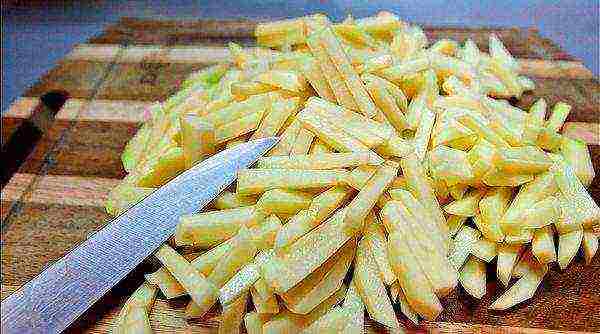
For frying
Suitable potatoes with a low starch content of 14-17%: "Impala", "Alena", "Sante", "Luck", "Ryabinushka".
For mashed potatoes
They choose potatoes with starch from 17 to 25%: "Gala", "Fairy Tale", "Nevsky", "Zarevo", "Verba", "Atlant", "Adretta".
For long-term storage
An early ripe crop can be stored until mid-autumn, then the tubers germinate and wither.
It is better to use medium and late potatoes for storage. It has a thick skin, is resistant to fungal diseases, does not rot during storage. Stored without significant weight loss "Nevsky", "Sante", "Minerva", "Slavyanka", "Gatchinsky" "Adretta".
Reviews of potato varieties
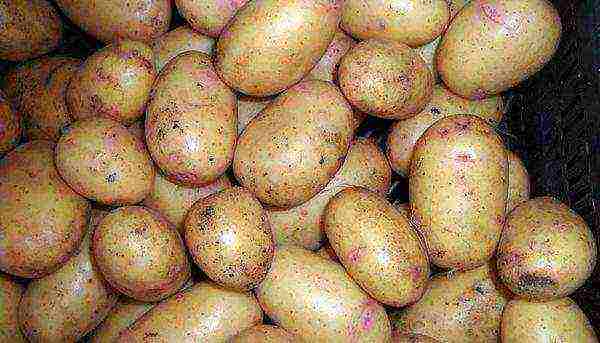
"Nevsky" is positively assessed by vegetable growers. This is a delicious potato with a yield of up to 15 tubers per bush. It is also immune to bacteria. Tubers are oblong, easy to clean without roughness. Potatoes "Nevsky" are heat-resistant. Therefore, it is cultivated in their gardens by amateur summer residents. It is also popular for commercial cultivation.
Bellarosa is an early table potato. Mass harvest is recommended 55 days after planting. You can selectively dig in the bushes already on the 40th day. For the opportunity to get young tubers so early, the variety is appreciated by summer residents. In addition, in areas with a mild climate, the variety is grown twice a season.
The advantage of Bellarosa is the ability to produce crops on heavy soils and on dry areas without an automatic irrigation system.
Temp potatoes are popular among gardeners. It has large tubers with a high starch content of up to 23%. It is used for industrial purposes, for making starch and dry purees. It is appreciated by private growers for its good taste and quick digestibility.
Choosing the best potato variety starts with studying the climate and soil composition of the region. With this approach, early potatoes will delight in harvest in early summer, and late potatoes are used during winter. The ability to navigate the varieties will help you choose the right vegetable for frying and various dishes: soups, side dishes, mashed potatoes.
Home / Garden and vegetable garden / Vegetables, berries and fruits / Varieties of late potatoes
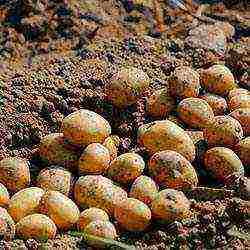
- 1. Potato variety Asterix
- 2. Variety of potatoes Zhuravinka
- 3. Potato variety Zarnitsa
- 4. Potato variety Zdabytok
- 5. Variety of potatoes Lorkh
Since we have already talked about early and mid-season varieties, now it is worth giving advice for gardeners optionally late varieties of potatoes... This is necessary so that you can fully weigh the pros and cons and make a decision, what to plant in the garden in spring.
Late varieties of potatoes preferable for the southern regions of our country. Unlike mid-season potatoes (which we talked about in this article), the growing season is 95-140 days. Dig late potatoes better in dry weather, it will extend the shelf life. Distinctive feature late potatoes its long shelf life is considered, in contrast to the early one (read about such varieties here). Most varieties retain their taste until the next summer. The starch content in late varieties is 12-20%.
The best late potato varieties to date are:
1. Potato variety Asterix
The potato variety Asterix was bred in Holland, it grows fruitfully in the Middle Volga and Far Eastern regions. Full ripening of the fruit occurs 110-120 days after planting. The bushes reach 80 cm in height, the flowers are red-purple, and the peel is red.On average, 2-2.5 kilograms are collected from a potato bush, and up to 300 centners can be harvested from one hectare. Resistant to diseases such as fusarium, cancer, golden potato cyst nematode. It is a virus-resistant potato variety. Has gained popularity due to its taste. It is widely used for making fries and chips.
2. Variety of potatoes Zhuravinka
Potato variety Zhuravinka bred in the Republic of Belarus, grows fruitfully in central Russia. Full ripening of the fruit occurs 100-110 days after planting. The bushes reach 60 cm in height, the flowers are red-purple, and the peel is red. On average, 16 medium-sized tubers grow on a bush, and up to 600 centners can be harvested from one hectare. Resistant to diseases such as nematode, black leg, cancer, scab. Susceptible to various viral diseases, late blight of leaves and tubers. The yield of the Zhuravinka variety is practically not affected by temperature drops. Withstands dry periods well, very quickly replenishes the lack of moisture during watering.
3. Potato variety Zarnitsa
Potato variety Zarnitsa bred in the Republic of Belarus, grows fruitfully in central Russia. Full ripening of the fruit occurs 120-140 days after planting. The bushes reach 60 cm in height, the flowers are red-purple, and the peel is red. On average, 12-16 tubers grow on a bush, the weight of one tuber can reach 160 grams, and up to 527 centners can be harvested from one hectare. Resistant to diseases such as nematode, black leg, cancer, scab. Susceptible to various viral diseases, late blight of leaves and tubers. Differs in excellent drought tolerance. Grows well in any soil.
4. Potato variety Zdabytok
Potato variety The surplus was bred in the Republic of Belarus, and is growing fruitfully in the central region of Russia. Full ripening of the fruit occurs 120-140 days after planting. The bushes reach 60 cm in height, the flowers are red-purple, and the peel is red. On average, 10-15 tubers grow on a bush, the average tuber weight is 100-120 grams, and up to 320 centners can be harvested from one hectare. Resistant to diseases such as nematode, black leg, cancer, scab. Relatively resistant to late blight pathogens. It has a high starch content of 25-28%. High storage degree.
5. Variety of potatoes Lorkh
The Lorkh potato variety was bred in Russia, it grows fruitfully in the central region of our country. It is one of the oldest potato varieties. Full ripening of the fruit occurs 120-140 days after planting. The bushes reach 80 cm in height, the flowers are red-purple, and the skin is light beige. On average, 10-15 tubers grow on a bush, the average tuber weight is 100-120 grams, and up to 350 centners can be harvested from one hectare. Resistant to diseases such as late blight, bacteriosis and viruses. Susceptible to infection with cancer and common scab. Poorly tolerates high temperatures and lack of moisture. It has a high starch content (up to 20%) and a long shelf life.
There are also many other early varieties recommended for cultivation in different regions of Russia:
Asterix, Atlas, Vetraz, Outflow, Blueness, Lorkh, Lugovskoy, Nikulinsky, Blakit, Picasso, Coastal, Lasunak, Aurora, Prinemansky, Ragneda, Zubrenok, Ramensky, Climber, Temp, Cardial, Krunur, Malinist, Victory, Alpinist Vesnyanka, Rodeo, Mondial, Vityaz, Lasunok, Naroch, Robin, Teterev, Agria, Peter's Riddle, Pyrol, Saturn, Synthesis, Seagull, Yavir, Bernadette.
If you do not want to miss new materials on our site, you can subscribe to updates.
Copying materials to your sites is allowed only with the indication of the author (Natalia Vasilevskaya or Dmitry Vasilevsky) and an indexed direct link to the site
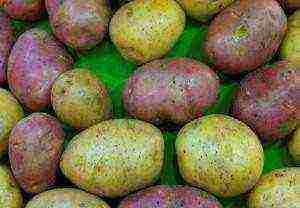 Potatoes reproduce well with tubers, which are selected from the general harvest, so many gardeners continue to grow "grandfather's" potatoes for decades. But this approach cannot be considered correct, since over the years, viral and mycoplasma organisms accumulate in the tubers. Even with good selection of seed potatoes (sampling in the field from well-developed healthy bushes of medium-sized tubers) and observance of storage conditions, the degeneration of varietal traits occurs over time.
Potatoes reproduce well with tubers, which are selected from the general harvest, so many gardeners continue to grow "grandfather's" potatoes for decades. But this approach cannot be considered correct, since over the years, viral and mycoplasma organisms accumulate in the tubers. Even with good selection of seed potatoes (sampling in the field from well-developed healthy bushes of medium-sized tubers) and observance of storage conditions, the degeneration of varietal traits occurs over time.
As a result, summer residents complain that the potatoes are getting smaller and the taste is not at all the same as before. In order to avoid a decrease in yields and an outbreak of viral diseases, it is recommended to periodically renew the potato planting material by purchasing high-quality varietal seed tubers from seed farms or from intermediaries.
Consider the popular varieties of potatoes for growing on a personal plot, when it is not the number of tubers in the bush that comes to the fore, but their size and taste. We recommend growing several varieties on the site at once with different ripening periods and varying degrees of resistance to weather factors, which will always allow you to stay with a good harvest, even in adverse weather conditions during the growing season.
It is also necessary to remember that a good variety will fully reveal its potential only in the zoning zone. By purchasing non-zoned varieties, gardeners always run the risk of being disappointed with the result.
Early potato varieties
In varieties with an early ripening period, the growing season (from germination to harvesting) averages 75 days. The most popular varieties in this group are: Red Scarlet, Luck, Rosara, Bellarosa, Impala.
Red Scarlet (Holland)
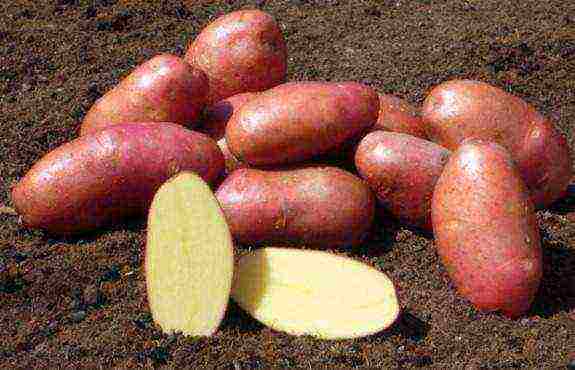
Productivity of marketable tubers: 164 - 192 kg / are, maximum - 400 kg / are.
Morphology of the bush: compact, undersized, light purple flowers.
Tubers: oblong, even with a smooth surface, small eyes, lilac peel, poor yellow flesh, average weight 80 g, in a bush 10 - 15 pcs.
Taste: average taste, does not boil when boiled, good for frying and for making French fries.
Cultivation zones: zoned for the Moscow region and the entire Central region, approved for cultivation in the North-West, Volgo-Vyatka and West Siberian regions, also recommended for the southern regions of Russia.
Peculiarities: heat-resistant, long-term, resistant to nematode and potato cancer, high yield of marketable tubers.
Disadvantages: susceptibility to late blight.
Growing recommendations: numerous reviews of the variety indicate good yields and high marketability even in unfavorable years. To prevent the development of late blight, it is necessary to carry out pre-planting treatment of tubers with fungicides approved for use in private household plots.
Luck (Russia)
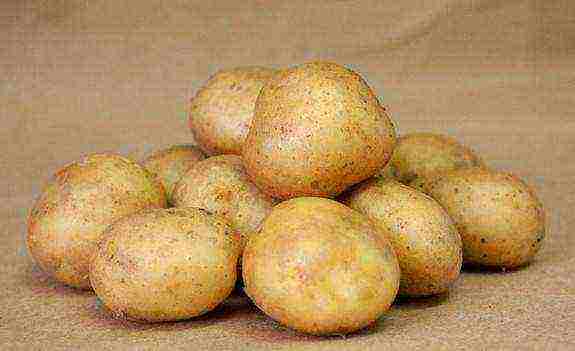
Productivity of marketable tubers: 300 - 400 kg / are, maximum - 500 kg / are, stable in different years.
Morphology of the bush: medium-sized, spreading, white flowers.
Tubers: oval with a light yellow thin skin and white flesh, the eyes are poorly expressed, the average weight is 150 - 200 g, in a bush 15 - 20 pcs.
Taste: good, but mediocre according to some reviews.
Cultivation areas: North-West region, Far East, Volga region, Central Chernozem region.
Features: it has a high resistance to diseases, drought-resistant, tolerates waterlogging, lodging.
Disadvantages: susceptible to nematode.
Growing advice: ecologically plastic variety, adapts well to extreme weather conditions and to all types of soil. Planting is recommended in well-warmed soil. Tubers grown using potash fertilizers darken during cooking.
Rosara (Germany)

Productivity of commercial tubers: 200 - 300 kg / are, maximum - more than 500 kg / are, stable in different weather conditions.
Morphology of the bush: medium-sized, semi-spreading, purple flowers.
Tubers: oval (sometimes drop-shaped), aligned, the color of the peel is red of varying intensity, the surface is slightly rough, the flesh is yellow, the eyes are not deep, the average weight is 90 - 120 g, in a bush 15 - 18 pcs.
Taste: excellent, low starch content, does not boil during cooking, ideal in salads and for frying.
Cultivation areas: the South Urals, the Far East and the middle zone of Russia.
Features: equally tolerates drought and waterlogging, resistant to nematodes, scab and late blight, a very early variety with high keeping quality.
Disadvantages: not identified by gardeners.
Growing advice: the variety retains yields for up to 5 years and does not require frequent seed renewal.
Bellarosa (Germany)
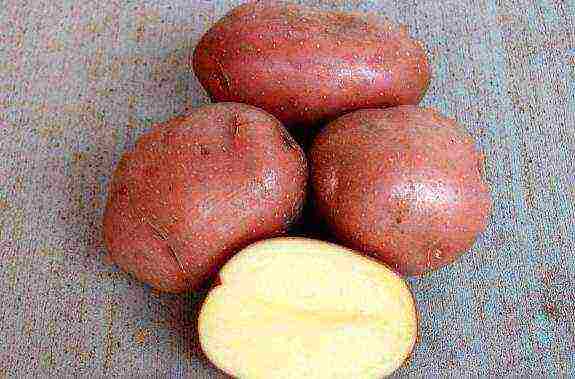
Productivity of marketable tubers: 170 - 330 kg / are, maximum - 385 kg / are.
Morphology of the bush: tall, erect with large leaves, red-violet flowers.
Tubers: round, leveled, the color of the peel is light red or pink, the surface is slightly rough, the pulp is light yellow, the eyes are shallow, the average weight is 110 - 210 g ("giants" up to 800 g), 9 pcs per bush.
Taste: high taste, friable boiled potatoes.
Cultivation zones: zoned for the Central European part (middle zone of Russia) and the Urals.
Features: high-quality variety with aligned tubers, resistant to viruses, nematodes, scab, cancer and late blight, very early.
Disadvantages: average keeping quality.
Recommendations for cultivation: to regulate the size of the tubers, the planting scheme is changed: by increasing the feeding area, large tubers are obtained, and with more frequent planting, medium-sized tubers. Cultivated on all types of soils. Popularly, this proven variety is often called Cherry, possibly because of the special fastening of the tubers and their appearance.
Impala (Netherlands)
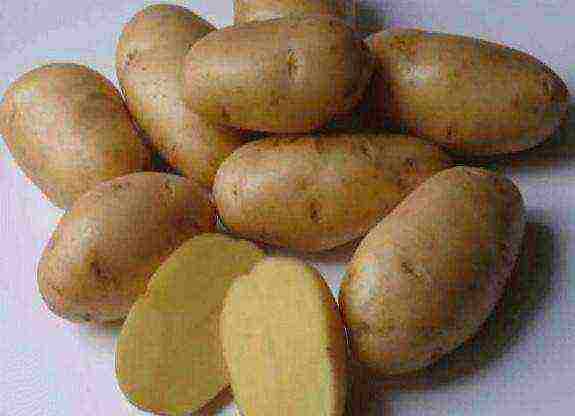
Productivity of marketable tubers: 180 - 360 kg / are, maximum - 367 kg / are.
Bush morphology: tall, powerful, white flowers.
Tubers: oval with sparse eyes, the color of the peel is white-yellow, the surface is smooth, the flesh is light yellow, the average weight is 100 - 150 g, 18 pcs per bush.
Taste: good taste, does not darken during cooking.
Cultivation zones: resistance to unfavorable weather factors and early maturity make it possible to grow this variety in most regions of Russia (Leningrad region, Moscow region, Volga region), it is popular in Belarus and Ukraine.
Features: very early (growing season 50 days), tubers are formed quickly and even in the first digging give a good yield with high marketability, well stored, resistant to nematodes and tuber cancer, weakly affected by scab and viral diseases.
Disadvantages: susceptibility to rhizoctonia and late blight.
Growing recommendations: the variety has positive reviews from both summer residents and large producers. In the southern regions of Russia and Ukraine, farms practice double planting of this variety (early spring and summer) for re-harvesting. To do this, the plants are dug out on a cloudy day, the formed tubers are carefully peeled off, and the bush is planted again, watered abundantly with water. In the middle lane, planting is carried out in early May after warming up the soil. It is strictly forbidden to cultivate without crop rotation.
Medium early potato varieties
This group includes varieties with an average ripening period of 75 - 85 days. In this category, gardeners prefer varieties such as Gala, Nevsky, Charodey and Adretta.
Gala (Germany)
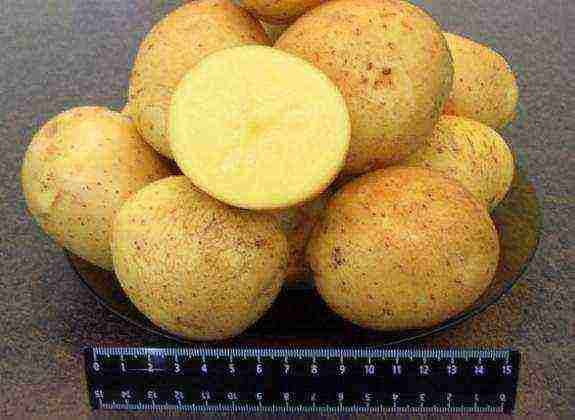
Productivity of marketable tubers: 400 kg / are.
Morphology of the bush: medium-sized with large leaves, single white flowers.
Tubers: round with small, shallow eyes and yellow veined skin, bright yellow flesh, average weight 70 - 120 g, 25 pcs in a bush.
Taste: good, low starch content, remains firm when cooked, suitable for salads and soups.
Cultivation zones: zoned for the North-West, Central and Volga-Vyatka regions, universal for cultivation in other regions of Russia.
Features: resistant to nematodes and specific diseases.
Disadvantages: susceptibility to rhizoctonia.
Recommendations for cultivation: the variety emerges evenly, the bushes form compact, which is convenient when leaving (weeding, hilling). Ideal for mechanized harvesting. A very unpretentious variety, gives excellent yields when cultivated on dry land. To increase the shelf life, it is recommended to mow the tops 2 weeks before harvesting, which will allow the tubers to ripen and stock up on nutrients.
Nevsky (Russia)
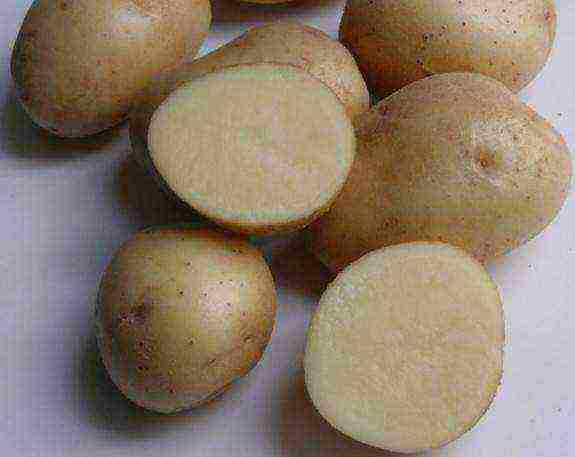
Productivity of marketable tubers: 380 - 500 kg / are, maximum - over 600 kg / are, stable.
Morphology of the bush: medium-sized, lush, white flowers.
Tubers: smooth oval with reddish eyes on a smooth white skin, white flesh, average weight 90 - 130 g, 8 - 15 pieces in a bush.
Taste: good, starch content is below average, peeled tubers do not darken for a long time, do not boil during cooking.
Cultivation zones: zoned in all regions of Russia.
Features: high marketability, good keeping quality, drought-resistant, resistant to cancer, late blight and rhizoctonia.
Disadvantages: does not tolerate a cold snap during planting and harvesting, early germination of tubers.
Growing advice: when planting sprouted tubers, do not break off the sprouts. The variety is responsive to fertilization and watering, therefore it is suitable for intensive cultivation. It is not recommended to plant in unheated waterlogged soil.
Sorcerer (Russia)
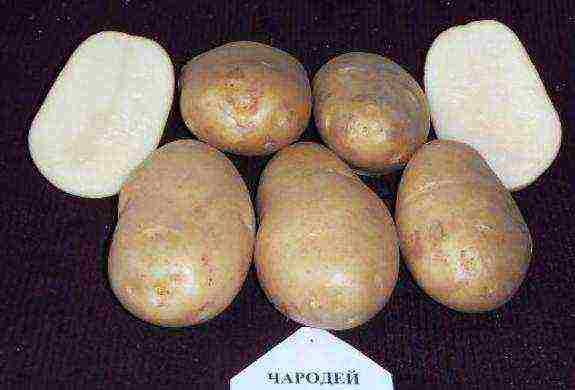
The yield of commercial tubers: strongly depends on the growing region and ranges from 174 to 370 kg / are, the maximum is 420 kg / are.
Morphology of the bush: erect with light green leaves, white flowers.
Tubers: oval with small inconspicuous eyes on a smooth yellow skin, white flesh, average weight 73 - 116 g, the number of tubers is not constant on different soils.
Taste: good, sweetish; tubers are easy to clean, do not darken during cooking, but become slightly crumbly; ideal for mashing.
Cultivation zones: zoned in the Northern, North-Western, Volgo-Vyatka, Central Black Earth, North Caucasian and Middle Volga regions of Russia.
Features: high marketability, high keeping quality, drought-resistant, resistant to cancer, medium resistance to late blight.
Disadvantages: susceptibility to nematodes.
Growing recommendations: mandatory preventive treatments against pests, rare planting scheme.
Adretta (Germany)
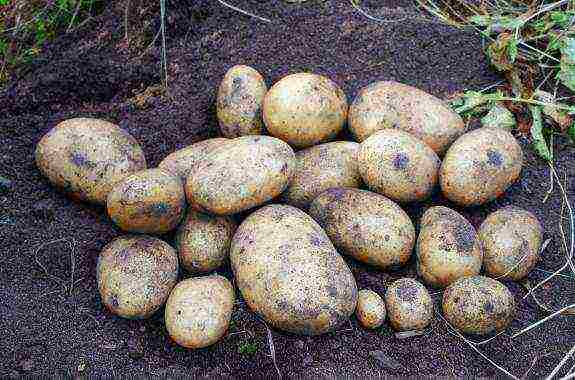
Productivity of marketable tubers: 214 - 396 kg / are, maximum - 450 kg / are.
Morphology of the bush: erect, vigorous, white flowers.
Tubers: rounded-oval with small and sparse eyes on a rough yellow skin, light yellow flesh, average weight 130 g.
Taste: medium, soft when boiled; tubers with a high starch content are suitable for mashing.
Cultivation zones: zoned in the Volga region, Western Siberia and the Far East.
Features: high marketability, good keeping quality, high resistance to viral diseases, early formation of tubers.
Disadvantages: Not noted.
Recommendations for cultivation: an unpretentious cultivar in cultivation, but does not tolerate a lack of moisture in the soil and irregular watering.
Mid-season potato varieties
An intermediate group of varieties with an average ripening period of 100 days. Tuleevsky, Roko and Aurora are in the greatest demand.
Tuleyevsky (Russia)
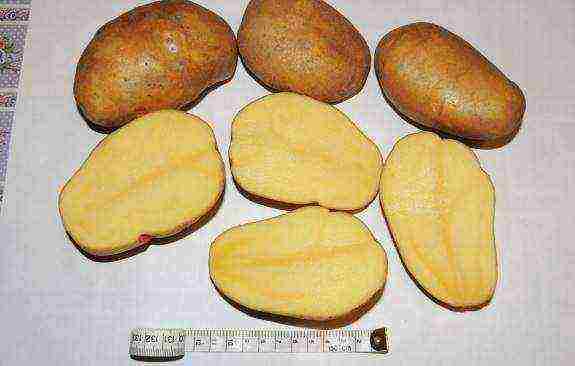
Productivity of marketable tubers: 180 - 424 kg / are, maximum - 500 kg / are.
Morphology of the bush: medium-sized, white flowers.
Tubers: oblong with small eyes, yellow peel with slight roughness, yellow flesh, average weight 122 - 270 g (tubers are found 500 g each).
Taste: excellent, medium starchy tubers.
Cultivation zones: zoned in Western and Eastern Siberia and the Far East.
Features: high marketability, good keeping quality, resistance to scab, slightly affected by late blight.
Disadvantages: susceptibility to nematodes.
Recommendations for cultivation: application of mineral fertilizers and irrigation negatively affect the marketability and safety of root crops during storage.
Rocco (Holland)
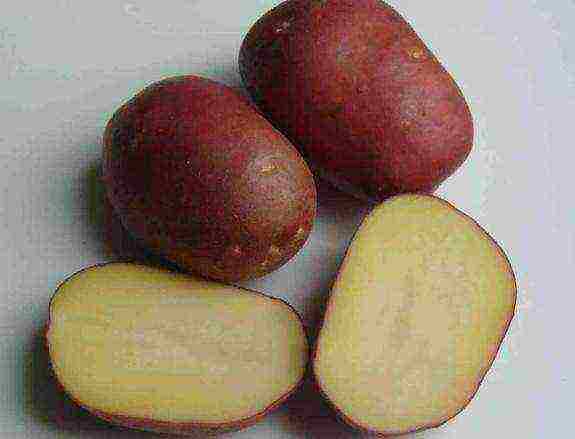
Productivity of commercial tubers: 136 - 261 kg / are, maximum - 400 kg / are, stable.
Morphology of the bush: erect, not spreading, red-violet flowers.
Tubers: oval with sparse eyes, the peel is red, smooth, the flesh is creamy, the average weight is 75 - 120 g, in a bush 8 - 12 pcs.
Taste: good, medium starch content.
Cultivation zones: zoned in the Middle Volga region.
Features: marketability and keeping quality at an average level, resistance to cancer, late blight and nematode, drought resistant, goes well for processing.
Disadvantages: not the best variety for long-term storage in unfitted cellars.
Growing recommendations: unpretentious, hardy enough to unfavorable soil and climatic conditions.
Aurora (Russia)
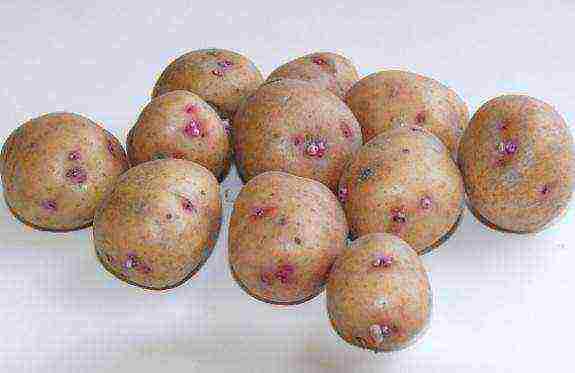
Productivity of marketable tubers: 214 - 396 kg / are, maximum - 416 kg / are.
Morphology of the bush: tall, with large leaves, purple flowers.
Tubers: oval with superficial eyes, beige peel, reddish in the area of the eyes, creamy flesh, average weight 93 - 128 g, in a bush 20 - 25 pcs. (according to some reviews, in some years this figure is close to 40).
Taste: excellent, high starch content, crumbly.
Cultivation areas: zoned in the North, North-West and Central regions.
Features: high marketability, keeping quality at an average level, resistance to cancer and nematodes, high drought resistance.
Disadvantages: a high level of agricultural technology is required.
Growing Tips: Tall stems need regular hilling to keep the bush from decaying. Top dressing significantly increases yields.
Late varieties of potatoes
This group includes varieties with a growing season of about 130 days. These varieties, as a rule, are distinguished by high yields and good preservation. The varieties Picasso and Zhuravinka deserve the greatest attention.
Picasso (Netherlands)
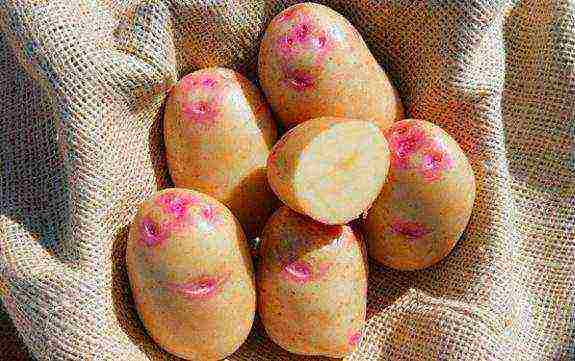
Productivity of marketable tubers: 193 - 315 kg / are, maximum - 321 kg / are.
Morphology of the bush: medium-sized, white flowers.
Tubers: oval with superficial eyes, yellow peel, pinkish around the eyes, creamy flesh, average weight 75 - 126 g, 20 pcs per bush.
Taste: good, low starch content, does not boil over.
Cultivation areas: optimal for the Moscow region and the Central Chernozem region.
Features: good keeping quality, resistance to cancer and nematodes, attractive appearance of aligned tubers, heat-resistant and drought-resistant.
Disadvantages: marketability strongly depends on growing conditions, susceptible to late blight.
Growing recommendations: it is advisable to grow according to intensive technology with the introduction of mineral fertilizers and organic matter. Germination of tubers is recommended before planting. It is better to plant less often, otherwise bulging of tubers to the surface is observed.
Zhuravinka (Belarus)
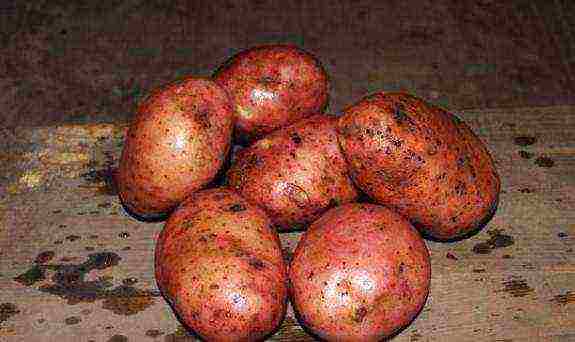
Productivity of marketable tubers: 400 - 600 kg / are, maximum - 750 kg / are.
Morphology of the bush: medium-sized, slightly spreading, red-violet flowers.
Tubers: rounded with shallow eyes, peel of uniform red color, pale yellow pulp, heterogeneous in weight (about 100 g or more), in a bush up to 18 pcs.
Taste: good, used for making chips and Belarusian potato pancakes, high starch content, boiled too much.
Cultivation zones: zoned in the North-West and Volga-Vyatka regions, recommended for cultivation in the Central region.
Features: good keeping quality, resistance to cancer, scab, late blight, viruses and nematodes.
Disadvantages: requires proper and careful care, but according to summer residents it is possible with minimal participation.
Growing recommendations: reacts negatively to increased doses of nitrogen fertilizers, is cultivated with regular irrigation (although, according to reviews, it tolerates irrigation interruptions well), prefers light soils. It is recommended to warm up the tubers before planting in order to stimulate the exit from the dormant period.
Interesting varieties not included in the state register
In addition to the varieties included in the state register, gardeners successfully grow unregistered hybrids and varieties. A short description of potato varieties for an experiment in trial plantings will help you choose the most exclusive options.
A new achievement of breeding is the mid-late variety Granada (Germany), which has a high yield (up to 600 kg / are), good keeping quality, resistance to major diseases and excellent taste with minimal care requirements. Recommended for cultivation in central Russia and Ukraine.
An old but little-known variety is Kiwi, which got its name from its dirty orange, rough peel, reminiscent of kiwi fruit. The pulp is white and cooks quickly. A feature of the variety is its excellent taste and resistance to the Colorado potato beetle. In each bush, about 20 medium-sized rounded tubers are formed.
The mid-season Sineglazka variety is loved by summer residents of the Moscow Region for its excellent taste and high potential, turning a blind eye to the insufficient keeping quality of tubers. However, it is ideal for summer consumption and private cultivation.
The early Riviera variety, entered in the register only in 2013, is also interesting, so there is still little information on the results of its cultivation. The patent holders declare this variety as high-yielding, with high storage capacity and relative resistance to major diseases. Its advantage is its high taste and rapid formation of tubers, which allows you to make the first digging already on the 45th day.
Even experienced potato growers will not be able to unequivocally answer the question of which potato variety is better. It all depends on the growing area, the type of soil, the characteristics of care and the level of agricultural technology. Early varieties are grown mainly for summer use, and it is preferable to lay varieties with late ripening for winter storage.
